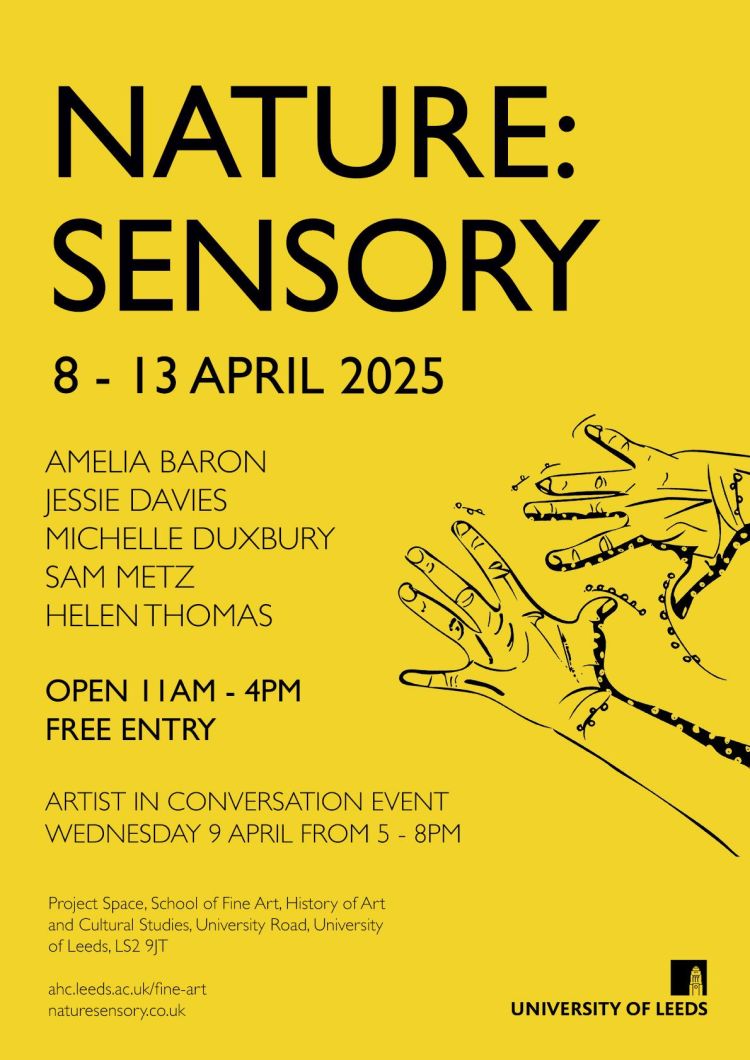Nature: Sensory – exhibition

- Date: Tuesday 8 April 2025, 11:00 – 16:00
- Location: Fine Art, History of Art and Cultural Studies
- Interval: Every day
- Until: Sunday 13 April 2025
- Cost: Free
Practice-led Postgraduate Researcher Michelle Duxbury is one of five artists showcasing work at this second iteration of Nature: Sensory in our Project Space.
Nature: Sensory reimagines how we experience the environment. The show explores alternative sensory engagements with nature that are more than just visual, such as the tactile qualities of materials or the rhythm of movement.
Showing work created by disabled artists and those living with long-term health conditions, the exhibition offers fresh, unique interpretations of Wakefield’s green spaces that challenge traditional perceptions of landscape.
Nature: Sensory is funded by a Culture Grant from Wakefield Council as part of Our Year – Wakefield District 2024 and supported by The Art House.
Find out more below about an in-conversation event with the artists on 9 April.
Featured artists
Amelia Baron
Amelia Baron is an artist and curator based in West Yorkshire. Her practice aims to visualise the themes of chaos and control in mental illness through endurance performance and installation. The use of delicate materials and repetitive motions take a metaphorical stance on the fragility and vulnerability of mental wellbeing, whilst also celebrating the strength and resilience of the individual. Brought up in Blackburn, Lancashire, Amelia’s journey into further education was unconventional due to lengthy stays in hospital due to ill mental health. Art became, and continues to be, a cathartic tool for recovery and a means of communication with friends, family and the wider community.
website: ameliabaron.co.uk
instagram: @ameliabaron_art
Jessie Davies
Jessie Davies is an artist whose work highlights important yet fragile wetland and woodland environments that play a vital role in our wider ecosystems. Living with multiple disabilities, including paraplegia and autism, Davies’ access to, and view of, the rural environment result in an acute observation of small, overlooked objects which nestle in the landscape. Immersing herself amongst the foliage of these terrains, she creates textural paintings and ceramics, often incorporating materials found in these habitats. Davies has developed her ceramics practice since 2022 through access to a wheelchair-accessible pottery wheel. The artist experiments with slips and glazes, using layering to create unique surfaces and textures.
website: jessiedaviesart.co.uk
instagram: @jessie_davies_art
Michelle Duxbury
Michelle Duxbury is an artist and postgraduate researcher from Leeds, with a studio practice based in Wakefield. Her work explores an intrinsic link between landscape, body and identity, and how our individual and collective (dis)connection to landscape can impact on our feelings of belonging/not belonging. She works with embroidery, moving image, sound and immersive installation work, using fictional narratives and speculative thinking to radically reimagine how disabled (and other marginalised) people might interact with landscapes they cannot be physically present in, drawing on her own experiences as a disabled, neurodivergent woman from a working-class background.
website: michelleduxbury.studio
instagram: @alabamathirteen
Sam Metz
Sam Metz is an artist who explores the concept of ‘neuroqueering’ ecology. Their work explores relational ecology considering chronic pain, disability and visual impairment, focussing on how stimming might support interpretation of landscape. As a neurodivergent artist and curator with sensory processing differences, Sam creates work in non-verbal ways that begin and end in movement and embodied interactions without recourse to traditionally privileged verbal and written forms of communication. Sam has made sculptural work for the exhibition, but their work deliberately sits between learning and engagement and curation.
website: sammetz.com
instagram: @chippedpale
Helen Thomas
Helen Thomas is a visual artist who works, predominantly with painting and drawing, in response to plants in the environment. Helen’s practice combines both field work and working from her studio at The Art House in Wakefield. Helen has congenital Nystagmus, a complex eye condition characterised by wobbling or flickering of the eyes. Nystagmus affects Helen’s vision and visual perception, causing blurred vision and oscillopsia (the illusory sensation that the stationary visual world is moving).
website: toastedorange.co.uk
instagram: @helenthomasartist

Venue
Project Space
School of Fine Art, History of Art and Cultural Studies
University Road
University of Leeds
Leeds LS2 9JT
AccessAble guide to the building.
In-conversation event
Join the artists on Wednesday 9 April from 5pm to 8pm for a special event to celebrate the exhibition, including an in-conversation with Ella Cronk from Yorkshire Sculpture International.
The in-conversation will start at 6pm and lasts about an hour. Guests are welcome from 5pm and the exhibition will remain open to 8pm.
All welcome.
Find out more about this free event and book your place for the in-conversation.
More information
You can find out more about Nature: Sensory by visiting the exhibition website naturesensory.co.uk and you can find us on Instagram @naturesensorywakefield
Image
Details from Forest, regrowth from fire by Jessie Davies (2024). Photo courtesy of the artist.

